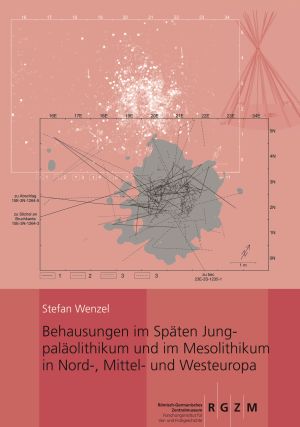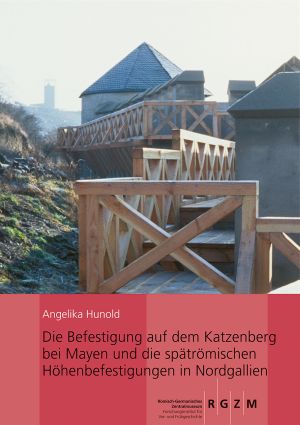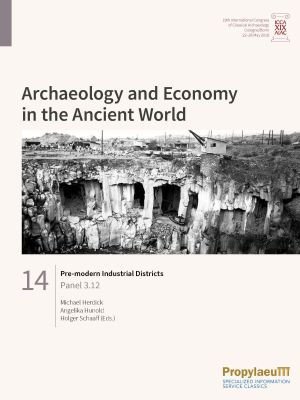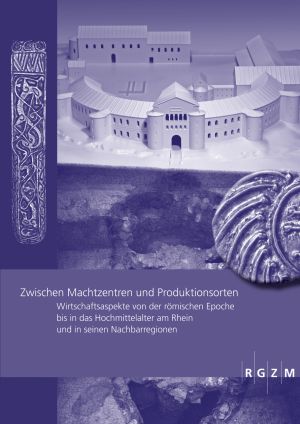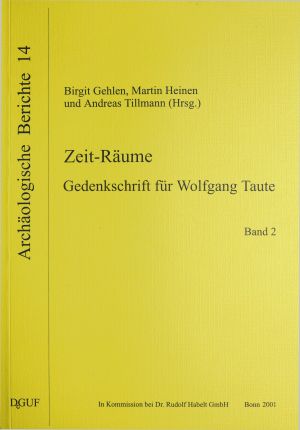Wenzel, Stefan
Behausungen im Späten Jungpaläolithikum und im Mesolithikum in Nord-, Mittel- und Westeuropa
Wo in der Zeit von 15000-5000 v. Chr. Jäger und Sammler in den Steppen und Wäldern Europas ihr Lager aufschlugen, blieben meist in großer Zahl Steinartefakte und Herdsteine zurück. Nur selten aber sind Wohnbauten anhand von erhaltenen Konstruktionselementen direkt nachweisbar.
In diesem Buch werden sechs Fundkonzentrationen daraufhin untersucht, ob es Indizien dafür gibt, daß ehemals Zeltwände einer diffusen Verteilung der Steinabfälle nach außen hin als Hindernis im Weg standen: Orp Ost und Rekem 10 in Belgien, Cepoy im Pariser Becken, Geldrop 3-2 in den südlichen Niederlanden, Berlin-Tegel IX sowie Hartmannsdorf 26 in Brandenburg. Bei diesen Siedlungsstrukturen wie bei den zum Vergleich herangezogenen Wohnbauten und nicht überdachten Lagerplätzen dieses Zeitabschnitts lassen sich ferner Arbeitsbereiche rekonstruieren, die Aussagen zur Organisation der jeweiligen lokalen Gruppen erlauben.
Römische Landnutzung im antiken Industrierevier der Osteifel
Seit Beginn der Römischen Kaiserzeit erlebte die Gegend zwischen Mayen am Rande der Eifel und Andernach am Rhein eine enorme Steigerung ihrer wirtschaftlichen Aktivität. In kurzer Zeit entstand dort ein Industrierevier, von dem aus weite Gebiete in den römischen Nordwestprovinzen mit hochwertigen Basaltlava-Mühlsteinen, leichten Tuffsteinen und später auch mit hitzebeständiger Keramik versorgt wurden. Steinbrüche wurden neu angelegt, Land- und Wasserwege ausgebaut, bestehende Absatzräume ausgedehnt und andere erst noch erschlossen. Auf Rückschläge im 3. und 4. Jahrhundert folgten weitere Boomphasen.
Wie konnten die zahlreichen Arbeiter und ihre Familien ernährt werden, und welche Folgen hatte der Erfolg der Stein- und der energieintensiven Keramikindustrie für die Umwelt? Um dies zu klären, wurden zwei römische Villen am Nordrand der Mayener Mühlsteinbrüche mit geophysikalischen Messungen, Grabungen, geoarchäologischen und botanischen Untersuchungen erforscht und ihr gesamtes Umfeld erkundet. Die Ergebnisse präsentiert dieses Buch. Die Bewohner der villa Mendig, »Im Winkel« waren selbst an der Herstellung von Mühlsteinen beteiligt. In der Spätantike dürfte eine Flächendrainage dort einen Umschlagplatz für Mühlsteine am Segbach trocken gehalten haben, während ein wehrhafter Speicherbau die Versorgung der Steinbrucharbeiter sicherstellte. In der villa Mendig, »Lungenkärchen« residierten Steinbruchbesitzer. Sie erwies sich als Axialhofanlage mit imposantem Wasserbecken. Begehungen führten ebenso zur Auffindung des zu »Lungenkärchen« gehörenden Begräbnisplatzes mit Monumenten aus Lothringer Kalkstein wie zur Entdeckung eines bislang unbekannten vicus »Im Terl«.
Die Befestigung auf dem Katzenberg bei Mayen und die spätrömischen Höhenbefestigungen in Nordgallien
Auf dem Katzenberg bei Mayen bestand von etwa 300 n. Chr. bis in die Mitte des 5. Jahrhunderts zum Schutz des Wirtschaftszentrums Mayen eine militärische Befestigung, die zu den größten ihrer Art gehört.
Ausgehend von den dort gewonnenen Ergebnissen werden 143 weitere Höhenbefestigungen in Nordgallien untersucht. An Verkehrswegen orientiert, vor allem an den Wasserstraßen, besitzen diese Anlagen keineswegs den Charakter versteckter Refugien. Vielmehr können auch sie als Militäranlagen eingestuft werden, die in ein übergreifendes Verteidigungskonzept eingebunden waren. Sie sicherten den Fortbestand des zivilen und wirtschaftlichen Lebens im ländlichen Raum. Somit bilden Höhenbefestigungen eines der Elemente einer tief gestaffelten militärischen Sicherung in der Spätantike.
Pre-modern Industrial Districts: Panel 3.12
Das antike Steinbruch- und Bergwerksrevier der Osteifel wird seit 1997 vom Römisch-Germanischen Zentralmuseum (RGZM) in Mainz und Mayen erforscht. Die Produkte – allen voran Mühlsteine aus Basaltlava, Baumaterial aus Tuffstein und Keramikgeschirr – wurden viele Jahrhunderte lang in weite Teile Europas exportiert.
Um dieses reichhaltige Bodenarchiv zur antiken Steinindustrie zu untersuchen und deren Rolle bei der römischen Okkupation und der Romanisierung nördlich der Alpen zu definieren, wurde ein umfangreiches Forschungsprogramm initiiert. Wesentliche Themen waren die Basalt- und Tuffsteinindustrie sowie das Wirtschaftszentrum Mayen. Die Keramikindustrie wird aus der Perspektive archäologischer Materialstudien, aber auch durch die experimentelle Archäologie untersucht. Weitere Studien widmeten sich den Voraussetzungen, unter denen sich der wirtschaftliche Aufschwung vollzog, insbesondere der Infrastruktur und der ländlichen Besiedlung.
Als Industrierevier von überregionaler Bedeutung erwies sich das Steinbruch- und Bergwerksrevier der Osteifel als hervorragende Fallstudie für die Erforschung vormoderner Industriereviere allgemein und ermöglichte die Ableitung eines Modelles zur Untersuchung antiker Industrien. Von besonderer Bedeutung für ihr Verständnis sind die Langzeitperspektive und ein ganzheitlicher Ansatz, der ökonomische und soziale Aspekte sowie die Siedlungsentwicklung berücksichtigt.
Zwischen Machtzentren und Produktionsorten: Wirtschaftsaspekte von der römischen Epoche bis in das Hochmittelalter am Rhein und in seinen Nachbarregionen
Am 12. November 2018 wurde in Ingelheim am Rhein ein Kooperationsabkommen zwischen der dort ansässigen Forschungsstelle Kaiserpfalz und dem Römisch-Germanischen Zentralmuseum, Leibniz-Forschungsinstitut für Archäologie, unterzeichnet. Damit wurden jene engen Verbindungen schriftlich verstetigt, die schon seit der Mitte des 19. Jahrhunderts zwischen den Mainzer Wissenschaftlern und den Erforschern der Ingelheimer Kaiserpfalz bestanden hatten. Im Fokus der zukünftigen Kooperation stehen besonders europäische Wirtschaftsaspekte und Themen der überregionalen Materialforschung. Erste Früchte dieser Zusammenarbeit konnten bei interdisziplinär angelegten Tagungen am 12. und 13. November 2018 in Ingelheim sowie am 28. und 29. November 2019 in Mayen vorgestellt werden. Diese Veranstaltungen dienten zugleich dem intensiven Austausch mit Wissenschaftlern aus dem In- und Ausland. Die Resultate beider Tagungen sind in diesem Tagungsband zusammengeführt. In 25 Fachbeiträgen werden die Grundlagen des Handels im Rheinland und seinen Nachbarregionen sowie die Vorgänge des Warenaustausches zwischen Machtzentren, ländlichen Regionen und Produktionsstätten im Zeitraum von der römischen Epoche bis in das Hochmittelalter aus ganz unterschiedlichen Blickwinkeln beleuchtet. Sowohl für die großräumigen Entwicklungstendenzen und die Beziehungen zwischen unterschiedlichen Wirtschaftsregionen als auch für die Produktionsstätten und die Vermarktungsrouten bieten die Beiträge richtungsweisende Ausführungen, grundlegende Darstellungen und außergewöhnliche Beschreibungen. Sie bilden die Basis für zukünftige Forschungen in an das Rheinland anschließenden Teilen Europas, die im Rahmen der Kooperation geplant sind und in weiteren Tagungen ihren Niederschlag finden sollen.
Zeit-Räume: Gedenkschrift für Wolfgang Taute. Band 2
Der zweite Band enthält Aufsätze zum eigentlichen Forschungsschwerpunkt von Wolfgang Taute, dem späten Paläolithikum, dem Mesolithikum und dem Altneolithikum in Nord- und Süddeutschland. Unter den zahlreichen hier vorgestellten Projekten, von denen eine ganze Reihe aus den Arbeiten von Wolfgang Taute hervorgegangen sind, nehmen die Ergebnisse der Untersuchungen zur La-Hoguette-Fundstelle von Stuttgart - Bad Cannstatt eine ganz zentrale Rolle ein.



